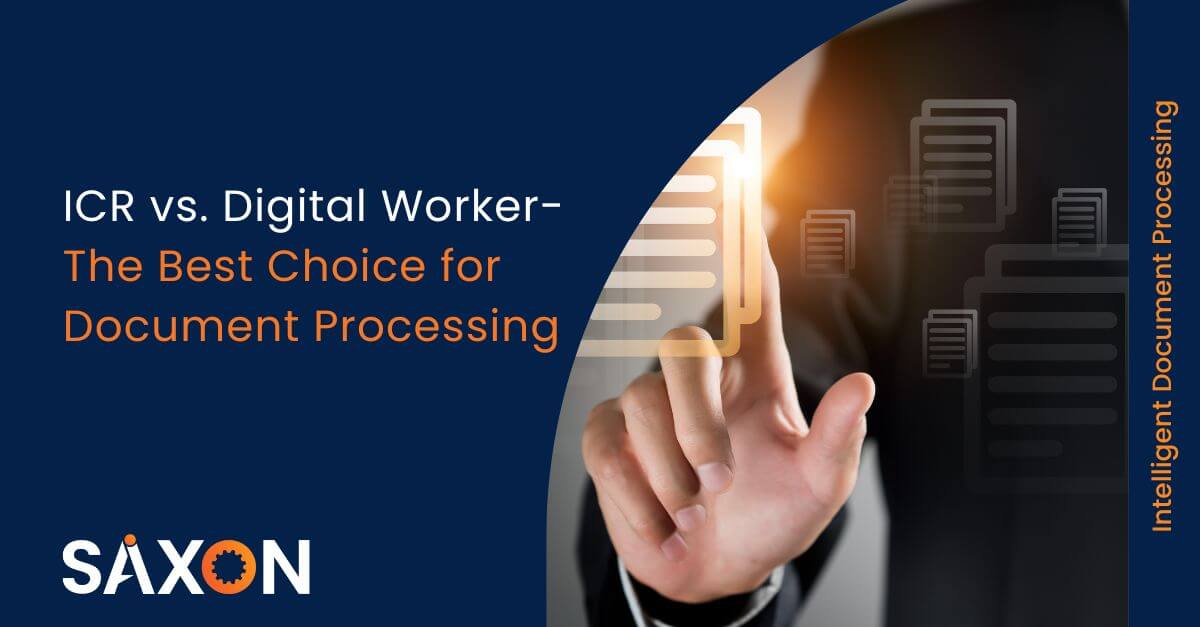Do you know that 80 to 90% of data that organizations collect and generate are unstructured? According to research, organizations spend over $30 billion on manually extracting data from documents. OCR (Optical Character Recognition) which has been present since a decade now helps solve the problem, but it is a simplistic rule-based software. However, with the advent of Intelligent character recognition (ICR) – AI-powered document intelligence, enterprises can process their data better.
Gartner evaluates that by 2024, the manual effort for contract review process will be reduced by 50% due to the adoption of Document Intelligence solutions. But now, with the advent of Digital Worker, we can see that they are a complete game changer. In this blog we will find out the most fitting choice between OCR vs. ICR vs. Digital Worker and explore the differences. At the end of this blog, you will have an overall view of data processing software, and which is the best suitable option for your business.
Importance of Document Processing
What is the core of any business? Undoubtedly, data and information are the nuclei of any business. However, most businesses are producing a staggering amount of data on a daily basis and it is necessary to process the data efficiently. With the generation of more and more data, organisations have to step up the Data Management game in order to keep up in the competition and thrive.
How to manage all the data?
Manually handling the massive amounts of data is not just challenging but also a very erroneous process to do. Here comes document processing solutions which can transform information from documents into usable data for the business. Data is the bloodline of any business and how efficiently we can process data/documents is a key to digital transformation. Yet, almost 80% of business data lie in unstructured and unreadable formats in images, embedded in emails, business documents, handwritten notes, signs and symbols, PDF documents and much more.
Intelligent document processing brings about a fresh revolution in the field of automation- that can extract and process data in various formats. Primarily, digitization of documents meant using OCR (Optical Character Recognition) software to recognise text and characters and convert them into machine readable data. It is still one of the key components of data management.
What is Optical Character Recognition (OCR)?
Optical Character Recognition (OCR) can transform a scanned image into text, it recognises characters and transcribes each of them. As a result, OCR can transcribe a document, providing a text representation of a scanned image. However, OCR does not provide much structured data. Here comes the advent of ICR or Intelligent Character Recognition that comprises of Artificial Intelligence + OCR, which allows the software to transcribe intelligently allowing it to deal with real-world challenges.
What is Intelligent Character Recognition (ICR)?
ICR or Intelligent Character Recognition is capable of interpreting handwritten/ printed characters, transcribe them into standard formats which are machine readable and consequently categorise and analyse the data. ICR can automate processes such as data entry, which is a tedious and error-prone task, and can achieve results within a shorter time period. Another advantage is that ICR can recognise all kinds of characters, in various languages, handwriting and fonts with accuracy. From raw unprocessed physical documents, ICR can recognise, interpret, analyse data.
Benefits of ICR
- From handwritten/printed information – convert to digital data
- Higher accuracy and reliable
- Using machine learning and AI (Artificial Intelligence), easily process and analyse data
- Incorporate in your Business process directly.
Digital worker also intelligently processes documents using ICR and provides fully managed services. Trending and rising, Digital workers are pre-built, AI-powered software which can process automation intelligently and independently just like a human team member.
What is a Digital Worker?
A digital worker is a software robot that is just like another teammate who can handle multiple tasks in a sequential order and manage the complete business task. When deployed as part of a multi-agent system, digital workers can coordinate with other AI agents or systems across departments, enabling large-scale process automation and collaboration. Using Artificial Intelligence, machine learning, ICR, conversational AI, Natural Language Processing and several intelligent automation processes, a digital worker is capable of not just a single task but the entire process. It can escalate matters/exceptions which needs a human’s cognition to the human in the loop and learn while doing.
Benefits of Digital Worker
Let us see some facts how a digital worker can help scale a modern enterprise:
- Digital Workers come fully trained for the process and can be customised
- They are immediately productive
- They do not need platform licensing costs
- No need to hire or train specialists to handle
- They learn and scale fast
- Work collaboratively with the team, escalate when required.
ICR vs. Digital Worker
The best document processing system for an organisation will definitely depend on the requirements and specific needs of the organisation. However, as data and documents are building blocks to any business, it is necessary to analyse the options from efficiency and cost perspectives to understand which option suits the modern enterprise the most. Here are a few pointers of using ICR vs. Digital Worker for data processing.
Cost Effectiveness
| License Costs | ICR/ Cognitive services have license costs which is based on usage. Whereas, in the case of Digital Worker, there are no license costs involved. It is included in the subscription. |
| Development Costs | Same as license costs, ICR has variable development costs which based on the complexity of the application. Digital Worker does not have any. |
| Infrastructure Costs | For ICR it is high and based on the consumption, whereas none in the case of digital worker. |
| Maintenance Costs | There are regular maintenance costs, and it is an ongoing process in the case of ICR. Digital worker does not have any as it is included in the subscription. |
| Monitoring Costs | Similar like maintenance, it is ongoing and regular for ICR software and none for Digital Worker. |
Feature based Comparisons
| Multiple ML (Machine Learning) models for different document sections | For ICR software to recognise different document sections such as images, checkboxes, paragraphs, handwriting and more, you need to develop it further and integrate add-on technology. Digital Worker will come fully prepared, as all the applications are baked into the service. So, the enterprise does not have to spend on further add-on software. |
| Human in the loop | When using ICR, the enterprise has to develop custom workflows and it requires integration. Whereas Digital Worker has human in the loop included in the service. |
| Integration | To integrate ICR, one has to build custom integrations. Digital Worker supports restful API for easy integration (apart from File based and email ones). |
| Granular security controls | You need to add on and develop customised apps for ICR. Digital Worker supports Role-based access control (RBAC) with a dedicated instance and privacy settings. |
| Active Learning | A digital worker actively learns and brings about continuous improvement in its processes. ICR services will require custom development and add-ons to bring about active learning feature in its use. |
Which one should you use: ICR or Digital Worker?
Based on these features and cost effectiveness, we can figure out that a Digital Worker is a more wholesome entity and a complete package of AI and cognitive abilities. Even when it comes to dealing and processing documents, it does not involve further expenditure on platform licensing, maintenance, development, and other costs. It can remember past interactions and learn from them, continuously improving results as it works.
In some cases, there are only few tasks to automate. For such cases, using ICR or Digital may suffice.
Take Away
The decision of going ahead with ICR vs. Digital Worker will depend on the business specificities. At Saxon AI, we help organisations move up the automation ladder by strategically addressing your business challenges so that you get paramount benefit. Whether it is Intelligent Document Processing or Digital Worker (Digital Clerx), contact us now for tailored solutions.


